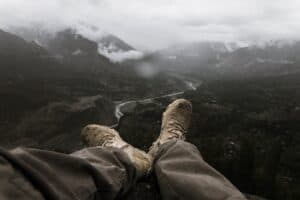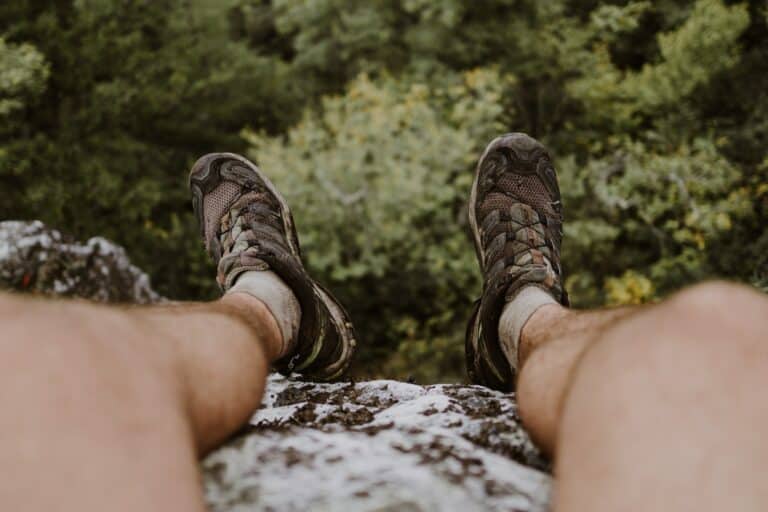Ever wondered, should hiking shoes be tight? Well, you’re not alone. It’s a common question that many outdoor enthusiasts grapple with. The fit of your hiking boots can make or break your adventure, and it’s essential to get it right.
In this article, I’ll delve into the nitty-gritty of hiking footwear. We’ll explore whether your hiking shoes should be snug as a bug or if a little wiggle room is the way to go. We’ll also touch on the potential consequences of ill-fitting shoes and how to ensure the perfect fit. Stay tuned for an enlightening read that could save you from a world of discomfort on your next hike.
So, tighten your laces (but not too much!) and let’s get started. Trust me, your feet will thank you later.
The Importance of Proper Fit in Hiking Shoes

Picking the right hiking shoes is a crucial step for every hiker. A proper fit can make your outdoor experience enjoyable, prevent discomfort, and most importantly, avoid injuries.
Hiking is a strenuous activity. Uneven terrain, demanding trails and prolonged periods of walking or climbing put a lot of stress on your feet. Imagine, then, the amount of strain your feet could experience if your shoes don’t fit nicely. That is why picking a perfectly fitting shoe for these outdoor activities is critical.
Wearing shoes that don’t fit leads to discomfort over a short period. Think about it: every mile you cover would be marred with discomfort, which could quickly escalate to pain. In worst-case scenarios, you might develop plantar fasciitis or have blisters on your feet. With hiking shoes that fit well, you’d minimize these chances.
- The shoe’s size should be correct not only in length but also in width.
- Your heel should not rub or slide when moving.
- Your toes should not hit the front of the shoes while descending.
As a hiker, there’s no compromise. Prioritizing well-fitting hiking shoes can hugely improve your hiking experience and reduce the risk of injuries. Opting for poorly fitting shoes is not only uncomfortable but might also endanger your overall foot health. And we haven’t even mentioned yet how the wrong shoes can affect your pace and stability during the hike.
To find the best fitting shoes, you might need to try different brands and styles. Each offers a unique fit, so it’s essential to try multiple options. Always remember, proper fitting can never be overemphasized in hiking shoes.
How Tight Should Your Hiking Shoes Be?
Now that we’ve established the potential perils of ill-fitted hiking shoes, let’s tackle an important question- how tight should your hiking shoes be?
Hiking footwear should indeed exhibit a snug fit but don’t misconstrue that as tight. It’s pivotal that your shoe isn’t squeezing your foot as that can stir discomfort or worse, foot ailments. The key lies in obtaining balance- the fit should be secure enough to prevent your foot from sliding, yet relaxed enough to forestall undue pressure or chafing.
A good rule of thumb is to ensure there’s no heel lift. This essentially implies that your heel remains planted in the shoe even when ascending steep terrains. Shoes that allow a lot of heel movement aren’t just uncomfortable; they are potential blister factories. One approach to test heel lift is to try climbing stairs or walking uphill in the shoes.
Remember, toes need wiggle room. Descending slopes can cause your toes to meet the front of the shoe frequently. If your toes feel squished or constantly hit the front of the shoe, you might be in for some toe injuries or blackened nails.
While lace tension can be adjusted, it’s vital to keep in mind that overtightening can lead to discomfort and blood circulation issues. The laces should be fastened enough to snugly secure the foot, without causing any discomfort to the instep.
Trying out different lacing techniques might aid in achieving the desired fit. Parallel lacing, for instance, can alleviate pressure on the top of your foot.
Purchasing a superior pair of hiking socks before trying on shoes is also a sound strategy. These socks can impact the shoe’s fit and your overall comfort. So, it’s justifiable to say that the right socks exercise an influential role in determining how tight your hiking shoes should be.
Selecting the right fit for your hiking shoes is a delicate dance between too tight and too loose. Involve your intuition, knowledge, and most importantly, your feet’s feel while making this choice.
Remember, there’s no “one size fits all” while talking about the perfect fit. It’s about listening to your feet and finding what feels right for you.
The Consequences of Ill-Fitting Hiking Shoes

Just as you wouldn’t use inadequate gear for your hiking trips, the same goes for neglecting the importance of proper fitting hiking shoes. Both tight and loose shoes can lead to quite a unpleasant situation. Trust me, you don’t want to find out the hard way.
Wearing tight shoes during hiking expeditions can cause multiple foot issues. Blisters and corns are just the tip of the iceberg. Excessive pressure on your foot may lead to more severe conditions such as metatarsalgia, inflammation in the ball of the foot, or neuromas, which are painful growths on the nerves of the foot. The more you hike with tight shoes, the more the chance these conditions will manifest.
On the other hand, loose shoes aren’t any better. They increase your risk of tripping or twisting an ankle. It’s because they don’t provide the necessary support and stability that your feet need during a strenuous hike. Moreover, the constant rubbing against the shoe can result in irritating blisters and cause discomfort.
To give you an idea of what improper hiking shoe fit can do, let’s look at a few common issues:
- Blisters: Caused by friction, these are most common in high flex areas such as the heel and toes. They’re painful and may even spoil your entire hiking trip.
- Numbness: If your shoes are too tight, they can compress your nerves, causing numbness in your toes. This condition might affect your hiking balance and hurt your overall experience.
- Black Toenail: This can happen when your shoes are too loose and your foot slides forward. The repetitive hitting of the toes on the front of the shoe can cause your toenails to turn black and fall off.
Tips for Finding the Perfect Fit

Ever wondered, “Should hiking shoes be tight?” Truth is, finding the perfect fit for hiking shoes isn’t just about size. It’s more about comfort and support. Your feet should feel snug, not squashed. Follow these tips to ensure you’re wearing the right size and fit.
Always Measure, Don’t Estimate
Foot size isn’t constant. Factors like age, weight, and foot injuries can lead to changes. Always measure your feet before buying new hiking shoes. And remember, it’s best to measure in the afternoon as feet tend to swell as the day goes on.
Try On Multiple Sizes
Don’t assume that you’re a certain shoe size across all brands. Sizes differ massively between manufacturers. Always try on several pairs and sizes to find the most comfortable fit.
Consider Width and Length
Proper hiking shoes will be snug but won’t pinch anywhere. Your toes should have enough room to wiggle but not so much that your foot slides around. The width should feel snug but not tight.
Test the Shoes with the Right Socks
Dress with the same socks during the shoe trial that you’d wear on a hiking trip. Remember, thick hiking socks might demand a larger shoe size.
Think About Break-In Time
Some hiking shoes may require a break-in period. If the shoe fits well in the store but is a bit snug, it might loosen up a bit over time. But note, a shoe that hurts when new will likely never become comfortable.
Listen to Your Feet
Ultimately, no matter what guides or sizing charts suggest, your feet know best. Not all feet conform to “standard” sizes or proportions. Stand, walk, and even run in the shoes before making your decision.
You might be asking, “my old hiking shoes were a size 9, so why isn’t this size working?” Well, this isn’t uncommon. Each pair is different. And it’s essential to take time to find the perfect fit because choosing the wrong size can lead to serious foot issues. So, don’t rush! The right pair of hiking shoes is worth the effort. Your feet will thank you later.
Conclusion: Should Hiking Shoes be Tight
As we’ve journeyed through the terrain of finding the perfect fit for hiking shoes, we’ve discovered it’s not just about the size. It’s about comfort, support, and listening to what our feet are telling us.
Remember, measuring your feet before buying new shoes is key. It’s also essential to try on multiple sizes and consider both width and length. Don’t forget to test your shoes with the right socks and factor in break-in time.
Each pair of hiking shoes is unique, and taking the time to find your perfect fit can save you from serious foot issues down the road. So, should hiking shoes be tight? The answer is no. They should be snug, but comfortable, offering the support you need for your outdoor adventures.
In the end, it’s not about how tight your hiking shoes are, but how well they fit you. Happy hiking!


